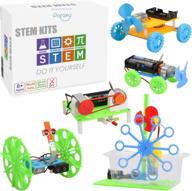
Review on 🌡️ Sunnytech Educational Stirling Engine for Temperature Understanding by Bryan Reynolds

exactly why the engine is running, in detail
This is an elegant engine, both in appearance and in operation. You can see all the parts moving. Of my five Stirling engines, it performs best at low temperatures. The Stirling engine is a heat engine, just like steam engines, petrol engines, hurricanes and the busy swinging drinking bird as a toy. The working piston is located in the large cylinder below. I call it the suppressor. It is driven by a crank on a flywheel. In a small cylinder, a working piston spins the flywheel twice per revolution, setting everything in motion. The displacer alternately moves the air in the piston cylinder to the bottom plate for heating and then to the top plate for cooling. This air is trapped inside the engine, so it cannot expand (or contract) as it heats up (or cools), but instead must increase (or decrease) its pressure compared to the air outside the room. The pressure differential causes two power strokes per revolution: one where the pressure in the motor is lower than the room pressure, so the working piston is pushed down, and the other where more pressure in the motor is pushing the working piston up. What is decisive for the Stirling engine is that the cranks control the pistons in such a way that the working piston is always a quarter turn behind the displacement piston in its movement. In this way, this displacement between piston movements causes the required pressure changes. The downstroke begins when the power piston is at the top of its cylinder and the displacer is in the middle of its downstroke. At this point, the air is divided evenly between the cooler upper part and the warmer lower part. The rotating flywheel pushes the power piston to start the power stroke. As the stroke continues, the propellant pushes more air into the cold upper section and the overall pressure inside drops below room temperature. therefore all the air is in the cooler part of the cabin. The pressure inside the motor is at its lowest, so the air in the room pushes the working piston down the hardest. This is the most powerful part of the work cycle, especially as this is where the power crank is focused on delivering maximum torque. The power piston continues its downward movement and reaches the end of this stroke. Now the upstroke begins, the functioning of which corresponds to the downstroke. You can see two working strokes, one down and one up! Start the engine with a hot cup. After it starts moving at about 1 RPM (60 RPM), remove it and place it on the table. Watch it slow down and stop. On the last 2-3 revolutions, the flywheel moves with a noticeable jerk with each hit. I find the easiest way to see this is by looking at the handle. The upstroke is harder to see because the motor is not in rotational equilibrium. The flywheel is probably balanced, but the combined weight of the pistons pulling down throws the system out of balance. This statement raises a number of questions. The most important of these is that we know that heat flow between air and a nearby plate is not instantaneous. But there's a hint that it's really, really fast. When the engine is running, the edge of the top plate heats up much more than the center of the plate. (I took the temperature of the plate with one of those thermometer "guns" whose laser pointer shows a red dot showing exactly where it's being tested.) At the edge, the hot air under the propellant flows into the upper space . That this location is much hotter than the rest of the plate suggests that much of the heat from below here is dumped quickly before the air moves further into the cold region. Another point: the engine takes in air from the space between the piston and the cylinder wall. This leakage is slow enough not to affect motor efficiency. But leakage is critical! If the engine weren't leaking, it would soon stop working at all! The air inside the engine gets much hotter than outside, and therefore its pressure is enough to push the power piston all the way up and lock it there! However, this can be avoided because some of the internal air escapes to the outside and the internal pressure (averaged over the cycle) adjusts again to the external pressure. You can see this leak for yourself. Hold a cold engine with the power cylinder in a horizontal position. Rotate the flywheel so that the working piston is at one end of its travel and hold it in that position for about 20 seconds. Then rotate the flywheel so the piston is at the other end of allowable travel and release. You should see the plunger return to near where you held it! Repeat, this time starting with the plunger at the other end.
- EASY TO USE ---- Pour in a cup of hot coffee, put a stirling on the cup, it works like magic. When it slows down, the temperature of the coffee is drinkable. Enjoy the physical display of the transmission mechanism and coffee. It can also work on an ice cube. Some people place the stirling in a cup of hot water and place small ice cubes on top of the stirling. This makes the temperature difference much bigger than normal and then runs even faster and crazier. Just enjoy the toy!
- Communication with seller
New products
Comments (0)
Top products in 🔬 Science Kits & Toys

Light-Up Dinosaur Terrarium Kit For Kids, Volcano Science Kit For Kids Ages 4 5 6 7 8-12 Year Old Girl Birthday Gift, Arts And Crafts For Kids Ages 8-12, Educational Toys Creative Kids Games For Boys

29 Review

Kids Pretend Play Toys Doctor Kit - 37 Piece Educational Toy Dentist Medical Role Play Set For Girls Ages 3-6 By Gifts2U

47 Review

Large Bug And Butterfly Net With 14" Ring, 32" Depth - Extends Up To 36" Handle For Effective Catching - Ideal For Insects, Birds, And More - By RESTCLOUD

39 Review

STEM Kit For Boys Ages 8-12, DC Motor Model Car Building Set, Electric Engineering Science Experiment Projects Gift For Kids 8 9 10 11 12

41 Review
Another interesting products

PicassoTiles 3-In-1 Building Block Set: Rocket, Bus, Train Theme For STEM Learning And Early Education - Magnetic, Pretend Play Toy For Kids

32 Review

School Bus Busy Board Activity Set For Early Learning And Fine Motor Development - 12 Basic Skills To Learn To Dress And Play, Ideal Sensory Toy For Preschool Kids, Kindergarten And Travel

31 Review

MINIBEAR Kids Digital Camera: 40MP, 2.4 Inch Screen, 32GB TF Card - Instant Prints & Selfies For Girls!

40 Review

Educational Learning Games Buzzer With 5 Color Push Buttons - Great Tool For Activity Transitions And Game Show Zingers Attention Bell Answer Buzzers.

37 Review

